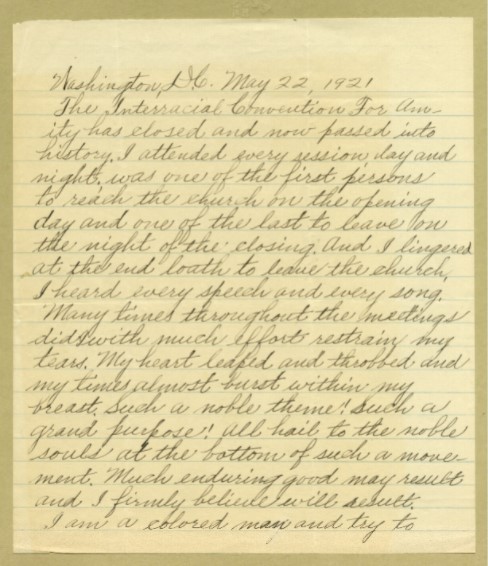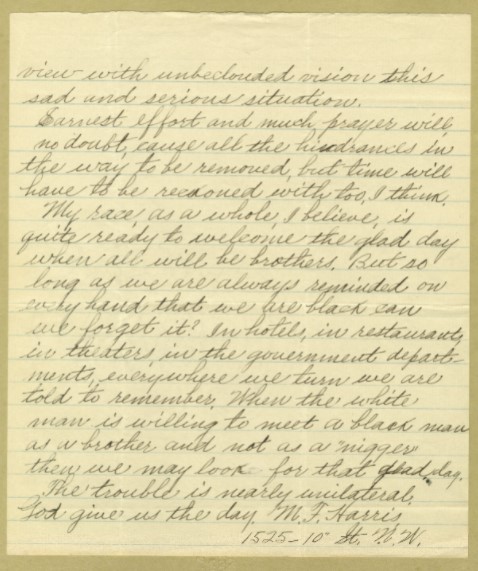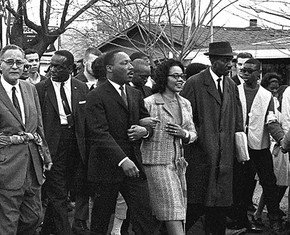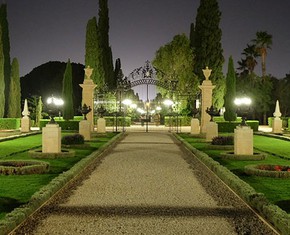The views expressed in our content reflect individual perspectives and do not represent the authoritative views of the Baha'i Faith.
No known photographs or recordings exist of the historic, Baha’i-sponsored “Convention for Amity Between the Colored and White Races Based on Heavenly Teachings” held 100 years ago.
RELATED: The First “Convention for Amity Between the Races”
But a Black Baptist Reverend named M. F. Harris wrote a remarkable letter of appreciation memorializing this special event. He sent it on May 22, 1921, the day after the Convention ended. Here is the original letter, in full — now published in its entirety for the first time — from the archival papers of Agnes Parsons, appointed the lead organizer of the groundbreaking event by Abdu’l-Baha:


The Interracial Convention For Amity has closed and now passed into history. I attended every session, day and night, was one of the first persons to reach the church on the opening day and one of the last to leave on the night of the closing. And I lingered at the end loath to leave the church.
I heard every speech and every song. Many times throughout the meetings did with much effort restrain my tears. My heart leaped and throbbed and my [sic: at] times almost burst within my breast. Such a noble theme! Such a grand purpose! All hail to the noble souls at the bottom of such a movement. Much enduring good may result and I firmly believe will result.
I am a colored man and try to view with unbeclouded vision this sad and serious situation.
Earnest effort and much prayer will, no doubt, cause all the hindrances in the way to be removed, but time will have to be reckoned with too, I think.
My race, as a whole, I believe, is quite ready to welcome the glad day when we will be brothers. But so long as we are always reminded on every hand that we are black can we forget it? In hotels, in restaurants, in theaters, in the government departments, everywhere we turn we are told to remember. When the white man is willing to meet a black man as a brother and not as a “nigger” then we may look for that glad day.
The trouble is nearly unilateral. God give us the day.
M.F. Harris
1525 – 10th St. N.W.
M. F. Harris has now been identified as Rev. Marion Francis Harris by the present writer’s brother, Carter Buck, and confirmed by Baha’i researcher Steven Kolins. More will be said about Rev. Harris after this brief comment on the above letter.
This otherwise optimistic and hopeful letter nonetheless serves as a grim reminder of the apartheid-like social conditions of America’s “Jim Crow” era of forced legal segregation. In the course of his letter of appreciation, Rev. Harris uses the “N-word” to make his point. It’s worth noting that at the time, the term “colored” was the socially-acceptable way to refer to people of African descent.
There is no mention of the word “Baha’i,” which pays tribute to the fact that this interracial convention was offered to the public without any overt religious affiliations, and therefore rendered as a public service in the interest of the greater good. This was a selfless contribution on the part of the Baha’i organizers who, as previously discussed in Part 63, decided to invite prominent non-Baha’i public speakers and noted performers, with Baha’is chairing the sessions throughout this three-day event.
Each session was therefore introduced in the Baha’i spirit of brotherhood and unity. This plan worked. The convention was a success, in that it obviously made a deep and lasting impression on Reverend Harris and presumably on other, like-minded conference participants as well, if Reverend Harris’ letter of appreciation fairly represents the impression of others who also attended this signal, socially revolutionary three-day event.
Thanks to the research assistance of Carter Buck and Steven Kolins, the following information on Rev. Harris has come to light: First, According to Carter Buck, Rev. Marion Francis Harris was born on April 3, 1874 in Arkansas, son of Rev. Randall R. Harris (1824–1910) and Susan “Susie” Harris (1839–1883). In 1870, Marion Harris’s parents were farmers in Clay, Columbia County, Arkansas.
His father Randall was born in North Carolina, and his mother Susan was born in Georgia. Since Marion lived on his parents’ farm, he was probably born there in 1874. His mother died in 1883, and his father re-married that same year.
In 1898, at age 25, Marion Harris, of Magnolia, Arkansas, married Nannie A. McCormack, also 25, in Ouachita County, Arkansas. Nannie was the daughter of Grant and Amanda McCormack in Clay, Columbia County, Arkansas. Their marriage license is available online here.
In the 1900 U.S, Census, they were both listed as teachers, living with an infant daughter (born December 1899) in Camden, Ouachita County, Arkansas. In the 1910 Census, they were living in Washington, DC, with a son, Marcellus Clarence (age 7), and daughter, Irene Frankie (age 2). At that time, Reverend Harris was employed as a government clerk, and his wife worked as a teacher.
In his 1918 Draft Card, he is described as “tall” and “medium” build, and he was employed by the U.S. Treasury Department. In the 1920 Census the family owned their home in Washington, DC. He was still employed as a government clerk, and Nannie was not employed.
In 1920, Rev. Harris was also listed as pastor of Mt. Hope Baptist Mission. Rev. Marion Francis Harris died on Jan. 7, 1928, age 53, in Clay, Columbia County, Arkansas, due to chronic interstitial nephritis. He is buried with his parents in Rocky Mount Cemetery in Columbia County, Arkansas. In 1940, the widow, Nannie, was living with her son in Washington, DC.
Steven Kolins adds: “It is very likely he knew Louis Gregory — they had the Treasury, religion, Howard University and law interests in common. Marion was also a law student at Howard University circa 1910–1913 though I can’t be sure he graduated.” While still a Howard University law student, “Mr. Marion F. Harris discussed somewhat at length the subject, ‘Would the Election of United States Senators be a Menace to Our Civil and Political Liberties?’”
RELATED: 100 Years Ago, Americans Came Together for Racial Amity
Perhaps, then, Marion Harris was present when, on April 23, 1912, Abdu’l-Baha spoke at Howard University in Rankin Chapel to a standing-room-only audience, concluding his talk with this memorable benediction:
I pray that you attain to such a degree of good character and behavior that the names of black and white shall vanish. All shall be called human, just as the name for a flight of doves is dove. They are not called black and white. Likewise with other birds.
I hope that you attain to such a high degree—and this is impossible except through love. You must try to create love between yourselves; and this love does not come about unless you are grateful to the whites, and the whites are loving toward you, and endeavor to promote your advancement and enhance your honor. This will be the cause of love. Differences between black and white will be completely obliterated; indeed, ethnic and national differences will all disappear.
On this Centenary of the landmark Convention for Amity Between the Colored and White Races Based on Heavenly Teachings held 100 years ago in Washington, DC, let us resolve, one and all, to carry forward the spirit of this watershed event, so that the conflagration of racial animosity may be quenched, and fire of racial prejudice be utterly extinguished, replaced by the spirit of interracial harmony and camaraderie to bring about racial justice.
















Comments
Sign in or create an account
Continue with Googleor